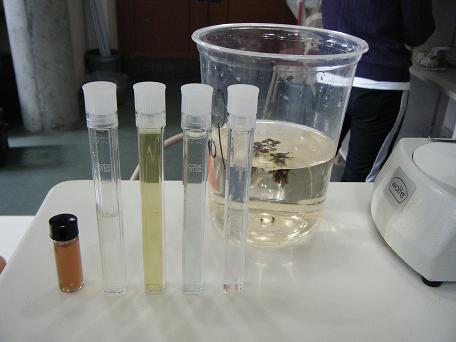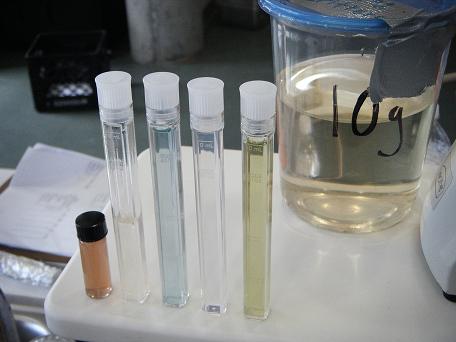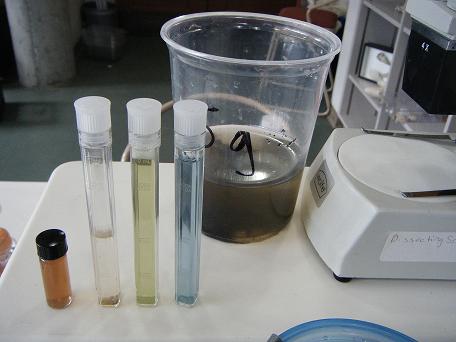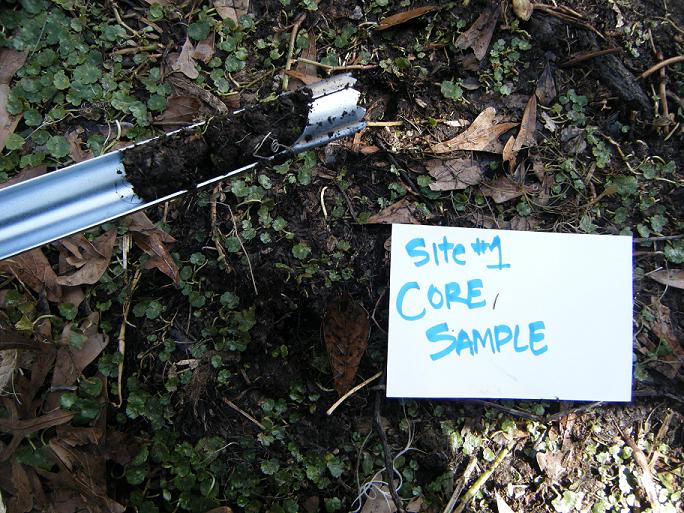The information that follows is the test results that we received upon going to the Jean Lafitte National Historical Park and Preserve.
Water Tests
At each test site, we took a sample of water to test for Coliform Bacteria, Dissolved Oxygen, Nitrates, pH, Phosphates, Salinity, and Turbidity. Coliform Bacteria is common in the environment and are generally not harmful. However, the presence of these bacteria in drinking water is usually a result of a problem with the treatment system or the pipes which distribute water, and indicates that the water may be contaminated with germs that can cause disease. Dissolved oxygen analysis measures the amount of gaseous oxygen (O2) dissolved in an aqueous solution. Oxygen gets into water by diffusion from the surrounding air, by aeration (rapid movement), and as a waste product of photosynthesis. Total dissolved gas concentrations in water should not exceed 110 percent. Concentrations above this level can be harmful to aquatic life. Nitrates are nitrogen-oxygen chemical units which combines with various organic and inorganic compounds. Once taken into the body, nitrates are converted into nitrites. The greatest use of nitrates is as a fertilizer. The MCLG for nitrates has been set at 10 parts per million (ppm). pH is a measure of the acidity or basicity of a solution. The pH of pure water is 7. In general, water with a pH lower than 7 is considered acidic, and with a pH greater than 7, basic. The normal range for pH in surface water systems is 6.5 to 8.5 and for groundwater systems 6 to 8.5. Phosphorus is one of the key elements necessary for growth of plants and animals and in lake ecosystems it tends to be the growth limiting nutrient. Salinity is the saltiness or dissolved salt content of a body of water. It is a general term used to describe the levels of different salts such as sodium chloride, magnesium and calcium sulfates, and bicarbonates. Salinity is an ecological factor of considerable importance, influencing the types of organisms that live in a body of water. As well, salinity influences the kinds of plants that will grow either in a water body, or on land fed by a water (or by a groundwater). Freshwater should have < 0.05 % Salinity. Turbidity has no health effects. However, turbidity can interfere with disinfection and provide a medium for microbial growth. Turbidity may indicate the presence of disease causing organisms. These organisms include bacteria, viruses, and parasites that can cause symptoms such as nausea, cramps, diarrhea, and associated headaches.
Water Analysis Data TablesSite #: 1
Temperature (at site): 10.5˚ C
Temperature (testing): 17˚ C

[Tests]
|
Test |
+ or - |
Color |
Ppm |
Ppt |
pH |
JTU |
|
Coliform Bacteria |
+ |
Dark Yellow |
|
|
|
|
|
Dissolved Oxygen |
|
|
0 |
|
|
|
|
Nitrate |
|
|
0 |
|
|
|
|
pH |
|
Green |
|
|
7 |
|
|
Phosphate |
|
|
0 |
|
|
|
|
Salinity |
|
|
|
0 |
|
|
|
Turbidity |
|
|
|
|
|
0 |
Water Analysis Data Table
Site #: 2
Temperature (at site): 10.5˚ C
Temperature (testing): 16˚ C
[Tests]

|
Test |
+ or - |
Color |
Ppm |
Ppt |
pH |
JTU |
|
Coliform Bacteria |
+ |
Yellow |
|
|
|
|
|
Dissolved Oxygen |
|
|
8 |
|
|
|
|
Nitrate |
|
|
0 |
|
|
|
|
pH |
|
Green |
|
|
7 |
|
|
Phosphate |
|
|
1 |
|
|
|
|
Salinity |
|
|
|
0 |
|
|
|
Turbidity |
|
|
|
|
|
0 |
Water Analysis Data Table
Site #: 3
Temperature (at site): 10.8˚ C
Temperature (testing): 15˚ C
[Tests]

|
Test |
+ or - |
Color |
Ppm |
Ppt |
pH |
JTU |
|
Coliform Bacteria |
+ |
Yellow |
|
|
|
|
|
Dissolved Oxygen |
|
|
8 |
|
|
|
|
Nitrate |
|
|
0 |
|
|
|
|
pH |
|
Green |
|
|
8 |
|
|
Phosphate |
|
|
2 |
|
|
|
|
Salinity |
|
|
|
0 |
|
|
|
Turbidity |
|
|
|
|
|
100< |
Water Conclusion
All of the tests concur with what
is to be expected for a freshwater marsh area. The Coliform Bacteria was positive in all three sites. The Dissolved
Oxygen outcome could be inaccurate because you are supposed to perform the
test directly after collecting a water sample. Some oxygen could be lost in the
transfer between testing sites. Nitrates tests were negative or trace
but because of the distance from civilization this is to be expected. The pH
in the three test sites were between 7 and 8, and the regular for fresh
water systems is 6.5 to 8.5. Phosphates test levels were also very low
do to the distance from civilization. There was no Salinity because of
the marsh being a freshwater system closer to the land, if we went out further,
salt would begin to appear in the water system. The Turbidity of the
water was pretty low, except for in site 1. Site 1 was right on the shore and
very muddy.


Soil Tests
At each test site, we took a sample of soil to test for Soil pH, Nitrogen, Phosphorus, and Potassium (Potash). Soil pH is an important consideration for farmers and gardeners for several reasons: Many plants and soil life forms have a preference for either alkaline or acidic conditions, affecting the choice of crop or plant that can be grown without intervention to adjust the pH, diseases affecting plants also tend to thrive in soil with a particular pH range, and the pH can affect the availability of nutrients in the soil. Average soil pH should be in the range between 5 and 8, depending on the type of plants. Nitrogen in the soil is the most important element for plant development. It is required in large amounts and must be added to the soil to avoid a deficiency. Nitrogen is a major part of chlorophyll and the green color of plants. It is responsible for lush, vigorous growth and the development of a dense, attractive lawn. Nitrogen may enter the soil through rainfall, plant residues, nitrogen fixation by soil organisms, animal manures and commercial fertilizers. Phosphorus is an essential element classified as a macronutrient because of the relatively large amounts of phosphorus required by plants. Phosphorus is one of the three nutrients generally added to soils in fertilizers. One of the main roles of phosphorus in living organisms is in the transfer of energy. Potassium is a chemical agent which causes a number of chemical processes in plants. Potash is the common name for potassium carbonate and various mined and manufactured salts that contain the element potassium in water-soluble form.
Results
Site: 1
|
Tests |
Color |
pH |
Level |
Lb/Acre |
|
pH |
Blue |
7 |
|
|
|
Potassium |
|
|
Very low |
0-120 lbs/acre |
|
Phosphorus |
|
|
High |
+100 lb/acre |
|
Nitrogen |
Light Pink |
|
Very Low-Trace |
0-30 lb/acre |
Site: 2
|
Tests |
Color |
pH |
Level |
Lb/Acre |
|
pH |
Purple-Blue |
7.5 |
|
|
|
Potassium |
|
|
Very low |
0-120 lbs/acre |
|
Phosphorus |
|
|
High |
+100 lb/acre |
|
Nitrogen |
Light Pink |
|
Very Low-Trace |
0-30 lb/acre |
Site: 3
|
Tests |
Color |
pH |
Level |
Lb/Acre |
|
pH |
Green-Blue |
7.3 |
|
|
|
Potassium |
|
|
Very low |
0-120 lbs/acre |
|
Phosphorus |
|
|
High |
+100 lb/acre |
|
Nitrogen |
Light Pink |
|
Very Low-Trace |
0-30 lb/acre |
Soil Conclusion
The soil is again, what is to be expected being so far from
civilization; where pollutions, and synthetic nutrients are more abundant. Soil
pH 7, which is on the normal range
for soil. It is slightly more basic than most soil that is used for growing
crops. Nitrogen in the soil was very low as was Potassium (Potash) levels.
Phosphorus was very high which is healthy for plant growth.
